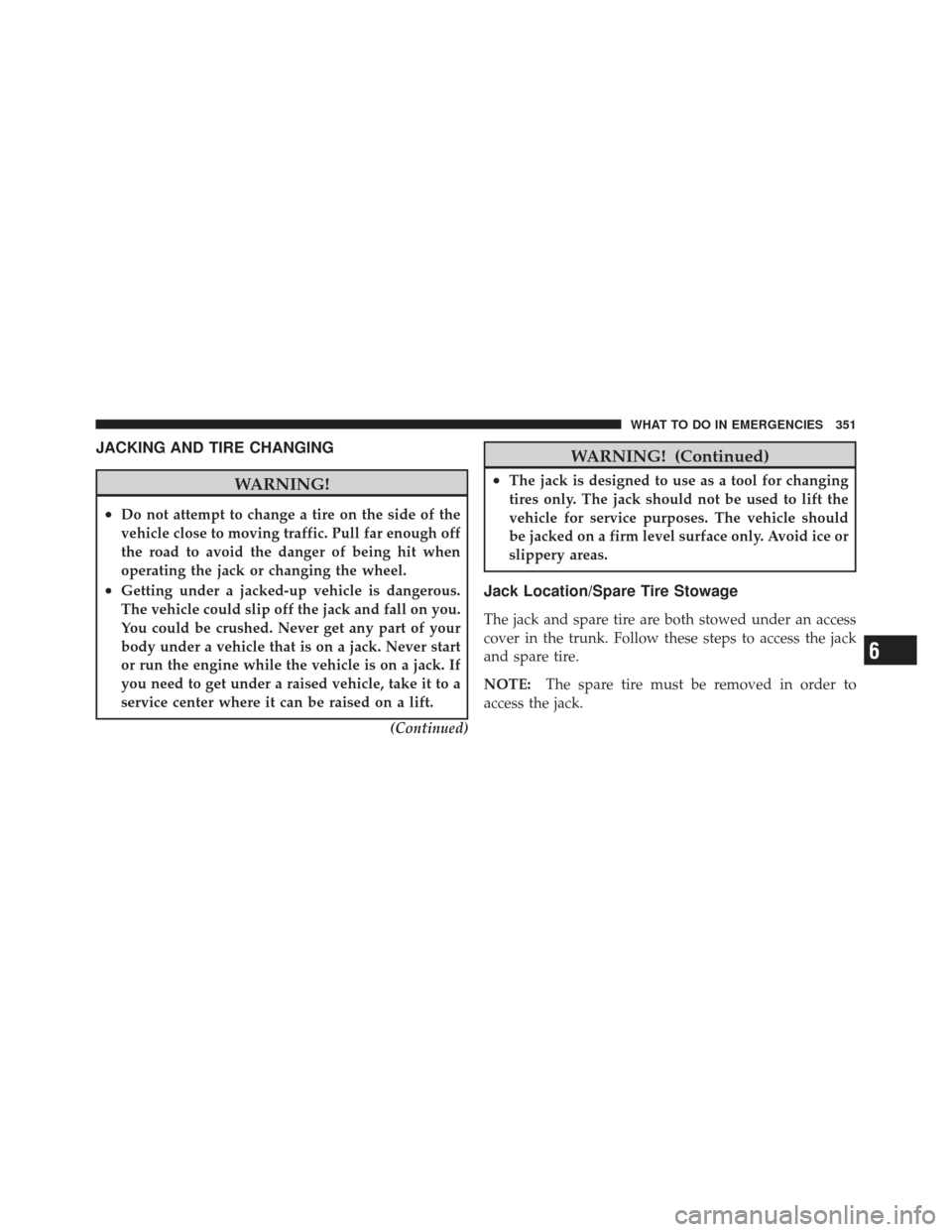Page 294 of 477
Tire Loading and Tire Pressure
Tire Placard Location
NOTE:The proper cold tire inflation pressure is listed
on the driver’s side B-Pillar.
Tire and Loading Information Placard
This placard tells you important information about
the:
1) number of people that can be carried in the vehicle
2) total weight your vehicle can carry
3) tire size designed for your vehicle
4) cold tire inflation pressures for the front, rear, and
spare tires.
Loading
The vehicle maximum load on the tire must not exceed
the load carrying capacity of the tire on your vehicle. You
will not exceed the tire’s load carrying capacity if you
adhere to the loading conditions, tire size, and cold tire
inflation pressures specified on the Tire and Loading
Information placard and in the “Vehicle Loading” section
of this manual.
NOTE: Under a maximum loaded vehicle condition,
gross axle weight ratings (GAWRs) for the front and rear
Tire and Loading Information Placard
292 STARTING AND OPERATING
Page 339 of 477
WHAT TO DO IN EMERGENCIES
CONTENTS
�Hazard Warning Flasher ................ 339
� If Your Engine Overheats ................ 339
� TIREFIT Kit — If Equipped .............. 340
▫ TIREFIT Storage ..................... 341
▫ TIREFIT Kit Components And Operation . . . 341
▫ TIREFIT Usage Precautions ............. 343
▫ Sealing a Tire With TIREFIT ............. 345
� Jacking And Tire Changing ............... 351
▫ Jack Location/Spare Tire Stowage ........ 351▫
Preparations For Jacking ............... 353
▫ Jacking And Changing a Tire ............ 354
▫ Compact Spare Tire ................... 358
▫ Wheel Cover Or Center Cap Installation —
If Equipped ........................ 359
� Jump-Starting Procedures ................ 361
▫ Preparations For Jump-Start ............. 362
▫ Jump-Starting Procedure ............... 363
� Freeing A Stuck Vehicle ................. 365
6
Page 353 of 477

JACKING AND TIRE CHANGING
WARNING!
•Do not attempt to change a tire on the side of the
vehicle close to moving traffic. Pull far enough off
the road to avoid the danger of being hit when
operating the jack or changing the wheel.
•Getting under a jacked-up vehicle is dangerous.
The vehicle could slip off the jack and fall on you.
You could be crushed. Never get any part of your
body under a vehicle that is on a jack. Never start
or run the engine while the vehicle is on a jack. If
you need to get under a raised vehicle, take it to a
service center where it can be raised on a lift.(Continued)
WARNING! (Continued)
•The jack is designed to use as a tool for changing
tires only. The jack should not be used to lift the
vehicle for service purposes. The vehicle should
be jacked on a firm level surface only. Avoid ice or
slippery areas.
Jack Location/Spare Tire Stowage
The jack and spare tire are both stowed under an access
cover in the trunk. Follow these steps to access the jack
and spare tire.
NOTE:The spare tire must be removed in order to
access the jack.
6
WHAT TO DO IN EMERGENCIES 351
Page 359 of 477
4. Place the jack underneath the lift area that is closest to
the flat tire. Turn the jack screw clockwise to firmly
engage the jack saddle with the lift area of the sill flange.
5. Raise the vehicle just enough to remove the flat tire
and install the spare tire.WARNING!
Raising the vehicle higher than necessary can make
the vehicle less stable. It could slip off the jack and
hurt someone near it. Raise the vehicle only enough
to remove the tire.
6. Remove the lug nuts, wheel cover (if equipped), and
tire. Remove the cover by hand. Do not pry it off.
7. Mount the spare tire.
NOTE: For vehicles so equipped, do not attempt to
install a center cap or wheel cover on the compact spare.
However, when reinstalling the road tire, follow the
procedure under “Wheel Cover or Center Cap Installa-
tion” in place of the remaining steps in this procedure.
Jack Engagement Locations
6
WHAT TO DO IN EMERGENCIES 357